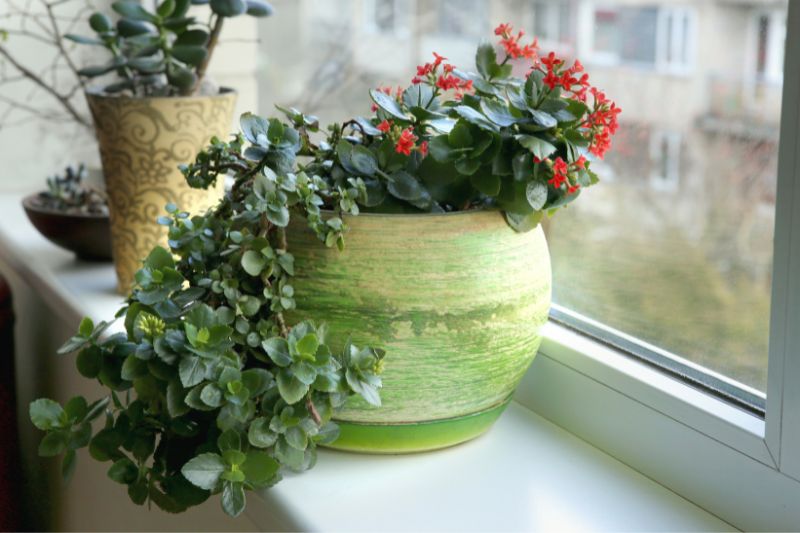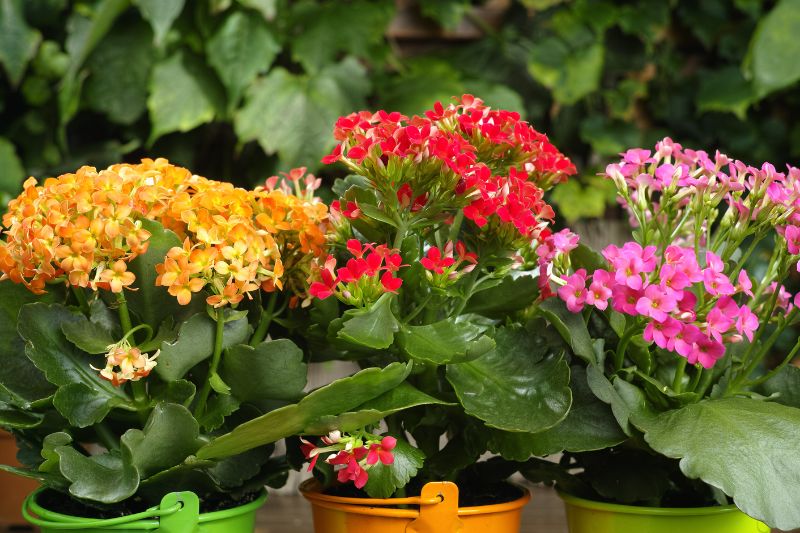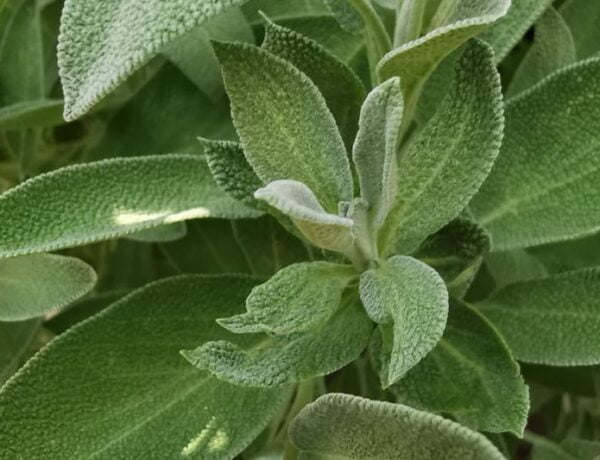Today’s plant care guide is about Kalanchoe blossfeldiana, a stunning succulent houseplant loved for its vibrant, long-lasting blooms and fleshy, jade-green leaves. With its easy-care requirements, it’s no wonder that this houseplant has become a popular choice for both novice and seasoned plant collectors alike.
Native to Madagascar, Kalanchoe blossfeldiana is a member of the Crassulaceae family and is commonly known by several names, including Florist Kalanchoe, Christmas Kalanchoe, Flaming Katy, and Madagascar Widow. This versatile plant also has a long history in traditional medicine, where it has been used to treat various ailments, thanks to its anti-inflammatory, antimicrobial, and analgesic properties.
As a tender perennial, Florist Kalanchoe can be grown outdoors in USDA Hardiness Zones 10 to 12, but it is more commonly grown as a houseplant in cooler climates. If you want your Kalanchoe to bloom beautifully and flourish for years to come, you must know how to take care of it properly, and that’s exactly the purpose of this article.
Table of Contents
1. General Information
| Scientific name: | Kalanchoe blossfeldiana |
| Common names: | Florist Kalanchoe, Christmas Kalanchoe, Flaming Katy, Madagascar Widow |
| Native to: | Madagascar |
| Toxicity: | This succulent is toxic to pets (cats and dogs) |
| Mature size: | 12 to 18 inches (30 to 45 cm) tall, with a similar spread |
| Category: | Flowering succulent |
| Growth Rate: | Moderate |
| Flowering Season: | Early spring to late summer |
| Dormancy Period: | Early autumn to mid winter |
| Hardiness: | USDA Hardiness Zones 10 to 12 (tender perennial) |

2. Kalanchoe Blossfeldiana Care & Growing Requirements
While Kalanchoe Blossfeldiana is an easy-to-grow plant, flowering requires some preparation. In this section, we’ll explain what you need to do to ensure your plant produces stunning blooms.
» Watering
As a succulent, Florist Kalanchoe requires less water than most houseplants. To prevent overwatering, allow the soil to dry out between waterings. This typically means watering your kalanchoe once every two to three weeks.
Use the “soak and dry” method: water thoroughly until water drains from the bottom of the pot, then let the soil dry out before watering again. Keep in mind that your kalanchoe may need more frequent watering during hot summer months and less during winter.
Also, make sure to avoid watering the leaves of your Kalanchoe plant. Instead, water the plant at the base, close to the soil. This helps prevent moisture from accumulating on the leaves, which can lead to fungal infections, rot, or other diseases.
» Light
Indoors, Florist Kalanchoe flourishes in a spot with bright, indirect light, where it can also bask in at least a few hours of sunlight daily. If natural light is insufficient, you can supplement with a grow light to keep your kalanchoe healthy and thriving.
As a “short-day plant” and a popular Christmas plant, this succulent requires specific light conditions to trigger blooming. This process typically occurs naturally as the days shorten.
However, when days start to lengthen again, you can stimulate reblooming by providing your Kalanchoe with 12-14 hours of darkness and 10-12 hours of bright light each day. This can be achieved by covering the plant with a box or placing it in a dark room during the evening hours. Once flower buds emerge (within 4 to 6 weeks), you can return the plant to its regular light conditions, and it should rebloom beautifully.
» Soil
Kalanchoe plants prefer well-draining soil to prevent root rot. A cactus or succulent potting mix is ideal for Kalanchoe Blossfeldiana. You can also create your own mix by combining equal parts of potting soil, perlite or pumice, and coarse sand.
» Temperature
Kalanchoe blossfeldiana thrives in moderate temperatures, making it well-suited for most indoor environments. The ideal temperature range for it to properly flourish and bloom is between 60°F and 70°F (15°C to 21°C).
Even if they can survive in lower temperatures, keep in mind that too low or too high levels can inhibit flowering.
» Humidity
Kalanchoe plants are native to arid regions, which means they can tolerate low humidity levels. Typical indoor humidity is usually adequate for kalanchoe care.
» Fertilizer
Fertilizing your Florist kalanchoe isn’t a necessary step in its regular care routine. However, this succulent will benefit from a balanced, water-soluble fertilizer. You can use one with a ratio of 20-8-20 diluted to half its strength and applied every four to six weeks during the active growing season, typically from spring through summer.
Alternatively, you can use a top dressing with compost and worm castings at the start of spring.
Avoid fertilizing or top dressing after summer, as the plant enters dormancy.

3. Kalanchoe Blossfeldiana Maintenance and Propagation
» Repotting
Repotting can be done every two years in spring, using a well-draining cactus and succulent potting mix and a slightly larger pot with proper drainage. Keep in mind that Flaming Katies thrive when rootbound, which reduces the risk of root rot and transplant shock, so repot only when necessary. Limited root growth can also encourage blooming.
Before repotting, water the plant in advance to minimize transplant shock. Carefully remove the Kalanchoe from its current pot without damaging its roots and place it in the new container. Fill the remaining space with soil and water the plant thoroughly to help it acclimate to its new environment.
» Pruning
Pruning is essential for maintaining the shape and encouraging bushier growth in your Kalanchoe plant. It also helps remove dead or dying foliage, which can attract pests or diseases.
Regularly remove spent blooms and yellowing leaves to promote new growth and ensure your plant remains healthy.
For more extensive pruning, trim the plant back by 1-2 inches after the blooming season. Use clean, sharp pruning shears or scissors to make clean cuts and prevent damage to the plant tissue.
» Propagation

Kalanchoe blossfeldiana can be propagated through various methods, the most popular ones being leaf and stem cuttings.
For leaf cuttings, select a healthy, mature leaf from the parent plant, and let it dry for a day or two, allowing the cut end to callous. Place the calloused end in moist, well-draining soil or a cactus/succulent mix, and wait for roots to form. Keep the soil moist but not wet, and provide bright, indirect light during the rooting process.
Stem cuttings follow a similar method, but you’ll need a 2-4 inch long stem piece with at least two leaf nodes. Allow the cut end to callous for a few days before placing it in the soil. Water the cutting sparingly until roots form, and then transition to the regular watering schedule.
4. Common issues
» Poor Flowering
If your Kalanchoe blossfeldiana isn’t producing blooms or has fewer flowers than expected, it could be due to inadequate light, incorrect temperature, or insufficient darkness during the flowering season. Ensure your plant receives enough bright, indirect light, and maintain a consistent temperature of 60°F to 70°F (15°C to 21°C).
To trigger blooming, provide your Kalanchoe with 12-14 hours of darkness and 10-12 hours of bright light each day, mimicking its natural short-day conditions.
» Leggy Growth
Leggy or stretched-out growth in Kalanchoe blossfeldiana is typically a sign of insufficient light. If your plant isn’t receiving enough sunlight, it will stretch towards the light source, resulting in an elongated, weak appearance.
To resolve this issue, move your plant to a brighter location with indirect sunlight, or supplement its light with a grow light. You can also prune back the leggy growth to encourage bushier development.
» Deformed Growth
A pale center and misshapen growth in Kalanchoe blossfeldiana are often indicators of inadequate light exposure.
Ensure your plant receives at least an hour of direct sunlight, particularly during winter months, as sunlight provides essential nutrients that are converted into plant sugars.
» Scorched Leaves
Sunburn or scorching, characterized by browned edges on the leaves, can occur when your Kalanchoe blossfeldiana receives insufficient water and excessive sunlight. Although these plants are well-suited for sunny locations, those not acclimated to intense sunrays may exhibit signs of sunburn and environmental stress.
Prolonged exposure to sunlight can accelerate dehydration. To fix this situation, consider transplanting your Kalanchoe into a larger pot in the spring, allowing the roots to access more moisture-rich soil.
5. Dealing with Diseases & Pests
Kalanchoe blossfeldiana, like any other plant, can be susceptible to various diseases and pests.
Pests that may infest your Flaming Katy include mealybugs, spider mites, and aphids. These pests can cause damage to the plant’s foliage and compromise its health. Regularly inspect your Kalanchoe for signs of pest infestation and take appropriate action as needed. For a more detailed guide on identifying and addressing common pests, please refer to our article on this topic.
The diseases you should watch out for include fungal infections like powdery mildew and root rot, which are often caused by excessive moisture and poor air circulation. Bacterial and viral infections can also occur, leading to issues such as leaf spot and mosaic virus, impacting the plant’s overall health and appearance.
By being aware of the diseases and pests that can affect your Kalanchoe plant, you can take preventive measures and maintain a healthy, thriving plant.
Conclusion
Kalanchoe blossfeldiana is a stunning and resilient succulent houseplant that comes with vibrant and colorful flowers. With proper care, including the right balance of light, water, temperature, and humidity, your Florist Kalanchoe will reward you with beautiful blooms and lush foliage.
By paying attention to its care requirements and addressing common issues like diseases and pests, you can ensure the long-term health and success of your Kalanchoe.






No Comments